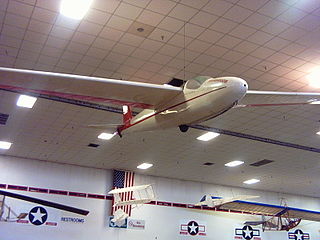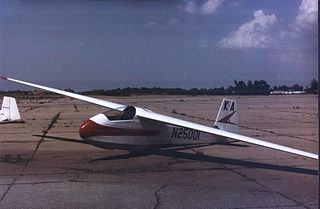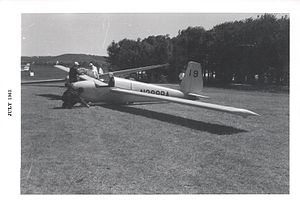
The Schweizer SGS 2-33 is an American two-seat, high-wing, strut-braced, training glider that was built by Schweizer Aircraft of Elmira, New York.

The Schweizer SGS 1-26 is a United States One-Design, single-seat, mid-wing glider built by Schweizer Aircraft of Elmira, New York.

The Schweizer SGS 1-23 is a United States Open and Standard Class, single-seat, mid-wing glider built by Schweizer Aircraft of Elmira, New York.

The Schweizer SGS 2-8 is an American two-seat, mid-wing, strut-braced, training glider built by Schweizer Aircraft of Elmira, New York.
The Schweizer SGU 1-19 and Schweizer SGU 1-20 are a family of United States single-seat, high-wing, strut-braced, utility gliders built by Schweizer Aircraft of Elmira, New York.

The Schweizer SGS 1-24, also referred to as the Schweizer-Burr SGS 1-24, is a United States single-seat, mid-wing, Open Class competition glider built by Howard Burr and Schweizer Aircraft of Elmira, New York.

The Schweizer SGS 1-34 is a United States Standard Class, single-seat, high-wing glider built by Schweizer Aircraft of Elmira, New York.

The Schweizer SGS 2-32 is an American two-seat, mid-wing, two or three-place glider built by Schweizer Aircraft of Elmira, New York.

The Schweizer SGS 1-35 is a United States 15 Meter Class, single-seat, mid-wing glider built by Schweizer Aircraft of Elmira, New York.
The Ross-Johnson RJ-5 is a single seat competition glider that was designed by Harland Ross and constructed partially by Ross and finished by Dick Johnson. The RJ-5 became one of the most famous gliders ever built when Johnson flew it 535 mi (861 km) in 1951, setting a new world distance record that endured for 13 years.
The Ross RH-3 is a single seat, mid-wing glider that was designed by Harland Ross.

The Leonard Annebula is an American high-wing, single-seat FAI Standard Class glider designed by Bob Leonard of Wichita, Kansas, based on the Hall Cherokee II.
The Laister LP-46 and LP-49 are a family of American high-wing, single-seat, gliders that were designed by Jack Laister and produced by Laister Sailplanes both as kit aircraft and as certified complete aircraft.
The Chase-Sisley C100-S is an American mid-wing, single seat FAI Open Class glider that was designed in the 1960s by Dr. Robert Chase.
The Bennett-Carter CBS-1 Dottie S is an American high-wing, strut-braced single-seat glider that was designed by George Bennett and Richard Carter and first flown in 1958.

The Kohler Alpha is an American, mid-wing, V-tailed, FAI Open Class single seat glider that was designed and built by Spud Kohler of Cleveland, Ohio.

The Prue Standard is an American high-wing, single-seat, V-tailed, FAI Standard Class glider that was designed by Irving Prue.
The Prue Super Standard is an American, high-wing, single-seat, FAI Standard Class glider that was designed by Irving Prue in 1962 as a development of the Prue Standard.

The N.V. Vliegtuigbouw 013 Sagitta is a Dutch mid-wing, single-seat Standard Class glider designed by Piet Alsema and produced by N.V. Vliegtuigbouw.
The Leffler-MacFarlane LM-1 is an American mid-wing, single-seat, FAI Open Class glider that was designed and constructed by Al Leffler, Walt MacFarlane and Bill Meyer, first flying in November 1963.












